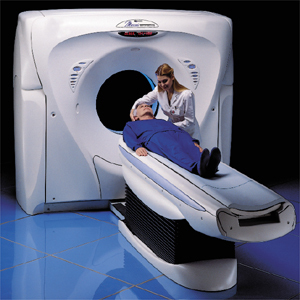CT dose-tracking software could help hospitals benchmark imaging quality
by
Brendon Nafziger, DOTmed News Associate Editor | August 12, 2011

Software that calculates personalized radiation dose from CT scans could help hospitals better track patient exposure and benchmark the quality of their imaging departments, according to a study presented at the 2011 American Association of Physicists in Medicine meeting this month.
"We're not keeping track of [radiation dose]," Dr. Ehsan Samei, study author and chief physicist and professor of radiology at Duke University Medical Center, told DOTmed News. "In most institutions, it's not monitored and it's not evaluated on a rigorous basis."
In general, the radiation dosage from CT scans captured by hospitals is based on output from the machine, and doesn't take into account patient-specific features, such as gender and age. As a result, risk estimates for patient populations at hospitals can be skewed, according to Samei.
Radiation risk is not one-size-fits-all. For instance, for reasons that are poorly understood, women are more vulnerable to radiation than men. Children are also more radiosensitive: their cells, growing rapidly, are more easily damaged, and they have longer lives ahead of them in which to develop radiation-induced cancers.
"There are huge variations from patient to patient that we're not accommodating," Samei said.
To fix this, Samei and his colleague Olav Christianson developed a computer program that would properly track radiation delivered to patients and gauge their risk by taking into account patient-specific factors. The program worked by capturing CT image data from the device that was uploaded to a dosimetry server.
The preliminary study, presented at the AAPM meeting in Vancouver, drew from 6,500 CT scans collected over a 5-week period at the Duke University Medical Center and Duke Raleigh Hospital.
A surprising result of looking at the data, Samei said, was the change in how risky the scans appeared to be to patients. By taking into account personalized dose statistics, risk estimates for patients at his hospital fell by a factor of two. That's because most of the patients showing up at the hospital for CT scans are older, Samei said, so they have a lower risk.
"If you don't take that into consideration, you'll come up with a risk factor that's significantly higher," he said. "Peak age [for scans] might be 60 years old. By saying everyone's 20-to-30 years old, you're overestimating the risk."
That said, Samei emphasized that the presumed risks from CT scanners are actually very small. The lifetime risk for getting cancer is already so high, at 42 percent, he said, it's hard to tease out the small likely additional risk contributed by relatively low-level medical radiation.
|
|
|
You Must Be Logged In To Post A Comment
|
